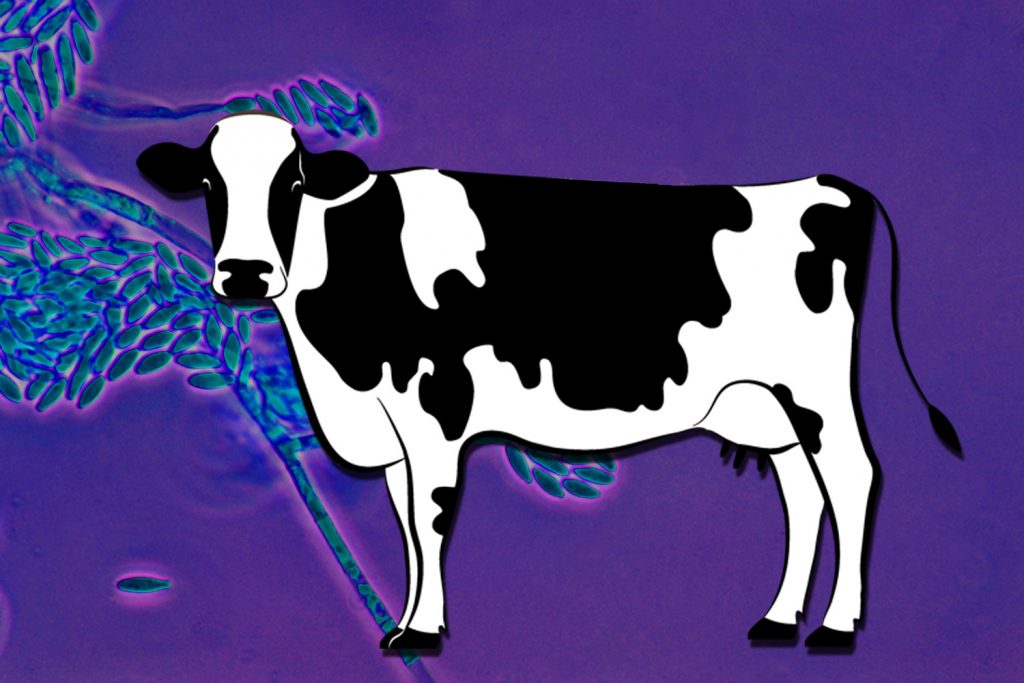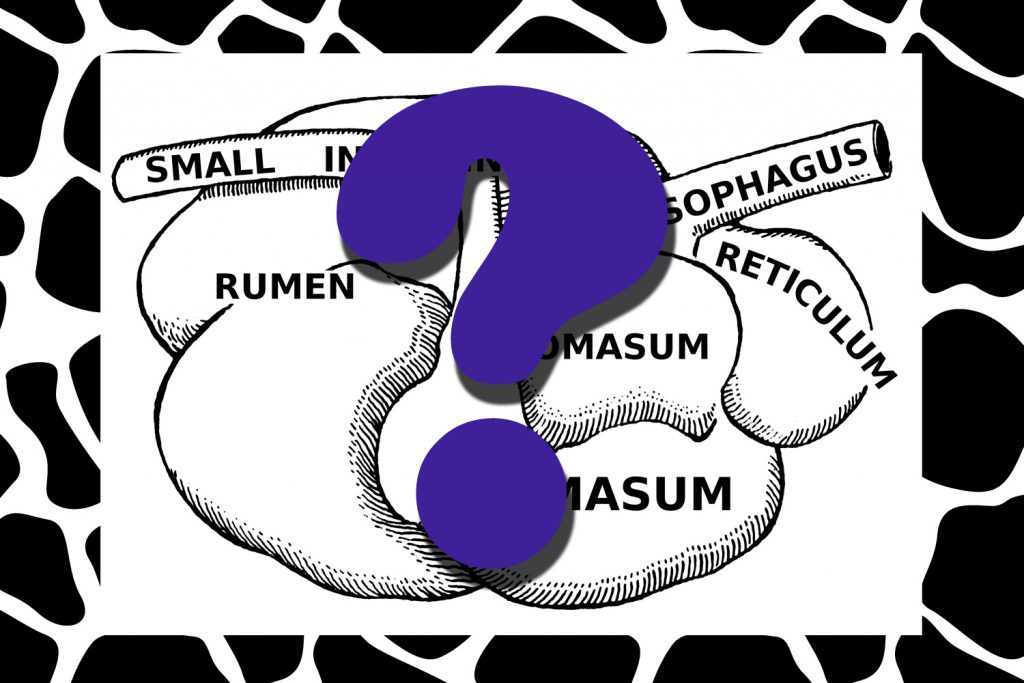28 Dec Mycotoxins in dairy cows

Can mycotoxins be completely detoxified in rumen?
The impact of mycotoxins on dairy cows is less studied than on pigs and poultry. Opposite to monogastrics, dairy cows have certain bacteria and protozoa in their rumen that, under certain circumstances, are able to totally or partially detoxify certain mycotoxins. For this reason, dairy cows and ruminant in general are less susceptible to the negative effects of fungal metabolites.
Can mycotoxins be completely detoxified in rumen?
Research shows that ruminal microorganisms are able to detoxify 98% of T-2 toxin, diacetoxyscirpenol and deoxynivalenol (DON, vomitoxin) in 6-24 h and 95% of ochratoxin A in 4 hours.
Regarding trichothecenes (T-2 toxin, HT-2 toxin, diacetoxyscirpenol and DON), they are almost completely inactivated in the rumen and do not produce systemic effects. Nevertheless, these mycotoxins give the feed an unpleasant taste, reducing feed intake and, as a consequence, reducing nutrient supply. Prior to detoxification, which as mentioned above takes 6 to 24 hours, trichothecenes irritate the epithelium of the digestive system, producing hemorrhages and impairing feed use.

Not all mycotoxins can be degraded in rumen:
- It can only detoxify 10% of total aflatoxins.
- 90% of zearalenone is converted to alpha-zearalenol, which is ten times more toxic than the parent toxin itself.
- Fumonisins cannot be detoxified, but as their bioavailability is very low, acute intoxications are unlikely.
Another factor to take in account is that dairy cows have a higher feed consumption and more stress than other ruminants, and these factors can impair the natural detoxification mechanisms and make cows more susceptible to mycotoxins.
Toxic effects of mycotoxins
Let’s review the toxicity of the different mycotoxins:
1. Effects of aflatoxins
The most relevant toxicity of aflatoxins is not on the cows themselves but their excretion through milk and their toxicity on human beings. In liver, aflatoxins B1 and B2 are metabolized into aflatoxins M1 and M2 (AFM1 and AFM2) and subsequently eliminated through milk.
Lactating cows that eat feed containing 20 ppb aflatoxins or more may produce milk that exceeds the tolerance level. 1-2% of aflatoxin B1 contained in feed is excreted as AFM1 in milk. After ingestion of AFB1, AFM1 can be detected in milk after 12 h and the maximum contamination peak will be 2-3 days later. When the cow returns to clean feed, the AFM1 concentration in the milk decreases to an undetectable level after 72 h (Van Egmond 1989).
Other toxic effects of aflatoxins are lameness and reduced fertility.
Guidance level: less than 10 ppb of aflatoxin B1 in finished feed (total mixed ration).
2. Effects of DON and T-2 toxin
The impact of DON on dairy cattle is not well studied but clinical data shows an association between DON and poor performance (Whitlow et al., 1994). A natural contamination of 2 ppm of DON reduces milk production by 13%.
In literature, the toxic effects of DON in naturally contaminated feeds are much more severe than those in studies made with artificially contaminated feeds. This may mean that, in order to have an impact on the animal, DON contamination must ocurr together with other mycotoxins that are not analyzed routinely in the lab. As a consequence, DON can be used as a marker for mycotoxin contamination, meaning that as long as DON is detected, the feed is very likely contaminated by other non analyzed mycotoxins.
DON has been linked to elevated somatic cell counts and mastitis.
Guidance level: less than 300 ppb in finished feed (total mixed ration).
T-2 toxin is toxic to all ruminants. It can cause:
- Feed refusal, low feed consumption and decreased milk production.
- Gastroenteritis, intestinal hemorrhages, bloody diarrhea.
- Absence of estrous cycles in cows fed 200 ppb during 20 days.
- Immuno-supression in young animals.
Guidance level: less than 150 ppb in finished feed (total mixed ration).
3. Effects of fumonisins
Fumonisins are structurally similar to sphingosine, a component of sphingolipids, a class of lipids that play important roles in signal transmission and cell recognition. Their toxicity results from blockage of sphingolipid biosynthesis and thus degeneration of the tissues. Fumonisins can cause decreased feed intake, less milk production and liver lesions.
Guidance levels: less than 5 ppm in finished feed (total mixed ration).
4. Effects of zearalenone
ZEN is an estrogenic metabolite that occurs in silage, corn, wheat, barley, oats, sorghum, hay and soybean. ZEN causes estrogenic effects as well as abnormal estrous cycles which ultimately impair fertility. Typical clinical signs are swollen vulvas, vaginal or rectal prolapses, vaginal secretions, poor reproductive performance, mammary gland enlargement of virgin heifers and higher occurrence of infections in the reproductive tract. It also causes poor feed consumption, depressed milk production and diarrhea.
Guidance level of zearalenone: less than 250 ppb in finished feed (total mixed ration).
Several strategies combined are necessary to prevent mycotoxin toxicity
Prevention of mycotoxin formation is essential since when mycotoxins are already present in feed, is more complicated to completely avoid toxic effects. Good silage management is of prime importance to avoid the growth of moulds and thereby prevent mycotoxin formation. Good silage-making practices emphasize:
- Harvesting at the proper moisture content;
- Chopping uniformly at the proper length;
- Filling the silo rapidly;
- Packing the silage sufficiently to exclude air;
- Using an effective fermentation aid;
- Covering the silage completely and well.
The routine addition mycotoxins binders to feed has been proved to prevent harm caused by mycotoxins. It is necessary to choose a mycotoxin binder that is effective not only for aflatoxins but also to trichothecenes and zearalenone, which are the most relevant mycotoxins for dairy cows. Our product PlusBind© is the ideal mycotoxin binder for ruminants, as it has been demonstrated with practical cases in dairy farms.
Ms. Li Zhichao, Technical Department
Products of choice
PlusBind© is a mixture of carefully selected silicates intended for the prevention of diseases and productivity losses related to the presence of all types of mycotoxins. It is indicated in poultry, pigs, aquaculture and ruminants.
The silicates present in PlusBind© have a highly expandable molecular structure. This characteristic gives the product a wide surface available for the adsorption of mycotoxins and therefore allows a high effectiveness at lower doses (0.5-1 kg per ton of feed).

Certain health statements may not be applicable in your region.

